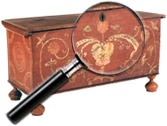Salted Paper Prints
It was Englishman William Henry Fox Talbot who in 1834 developed the photographic process that would become known as Salted Paper Prints. The process involved several steps. First, a good quality writing paper was soaked in a solution of sodium chloride or common salt and then was allowed to dry. After the paper had dried it was covered with a 20% solution of silver nitrate. This solution adhered to the paper’s fibrous surface but the amount of silver that stayed on the paper was only 1/10th of that found on modern photographic paper.
The next step was to lay a negative over the paper and then expose it to the sun, this was a fairly rudimentary means of exposure by today’s standards. Once the paper had been exposed, the image was fixed or developed by immersing the paper in a bath of concentrated silver nitrate, hyposulphite of soda and silver iodine. The final step could prove to be the most lengthy of the entire process, this was to remove any excess developing solution with water. Some records show that this could take up to 24 hours with many changes of water.
The early negatives were also on paper, therefore the quality and tonal range of the resulting print was fairly limited. The quality of these early prints varied greatly as did their life span, these factors mainly depend on how much care the photographer took when developing the image. Another key factor was the chemicals used and how well the residues were removed at the rinsing stage. The prints can range in tonal quality and color with tones in various shades of brown, lilac or primrose yellow in color.
The appearance of an early salt print that was not coated with a proprietary solution for protection is matte, because the image adheres to the paper fibers. Some prints were coated with an albumen solution thus giving a slightly glossy surface, these became known as albumized salt prints.
The main problem with salt prints is prolonged exposure to air causing the images to fade. Because of this many of the early examples by Fox Talbot and others have all but faded away. Images tucked away in albums tend to survive better than the images that were unprotected.
Salt prints do turn up and they are highly sought after by collectors because of their important place in photographic history. As with all forms of photographic images the price a collector can expect to pay will depend on the photographer, condition and subject matter.
This early format remained popular between 1834 and the early 1850′s when it was replaced by albumen prints.
Reference note by p4A.com Contributing Editor Robert M. Ginns.
